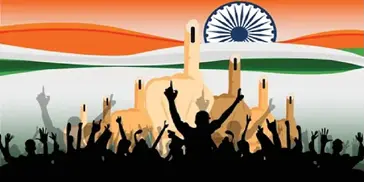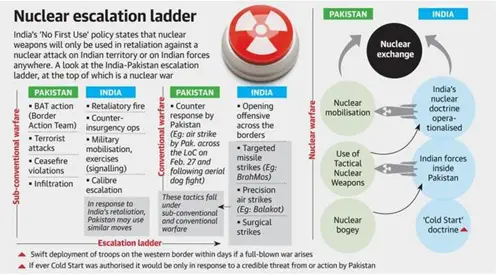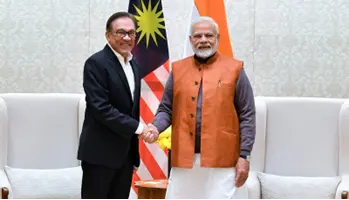Friday, 23rd August 2024
Why Laws on Sexual Violence Continue to be Skewed
Why in the news?
- Sexual violence remains a severe and widespread issue in India, exacerbated by a political, legal, and social framework that fails to adequately address and punish such crimes.
- Despite legal reforms and public protests, systemic flaws persist, leaving victims unprotected and justice elusive.

Systemic Impunity of Sexual Violence:
- Case Example:
- The brutal rape and murder of a resident doctor at RG Kar Medical College in Kolkata exemplify the systemic impunity that perpetrators of sexual violence enjoy.
- The case's transfer to the Central Bureau of Investigation (CBI) highlights a mistrust in local justice systems.
- Ineffectiveness of Legal Reforms:
- Intended to improve gender justice, the Bharatiya Nyaya Sanhita (BNS) has failed to foster a deterrent culture against sexual violence.
- The reform's focus on symbolic changes rather than substantive improvements has not effectively addressed or reduced violence.
Legal Reforms and Their Limitations:
- Symbolism Over Substance:
- Renumbering Crimes:
- Reorganising crimes against women in the penal code is a symbolic gesture that does not translate into practical deterrence or real-world impact. High rates of sexual violence persist, revealing the inadequacy of such reforms.
- Renumbering Crimes:
- Controversial Use of the Death Penalty:
- Debate on Effectiveness:
- The death penalty for sexual violence has been debated as ineffective in preventing crime. Critics argue it does not address root causes like societal attitudes and institutional failures and prioritises punitive measures over preventive ones.
- Debate on Effectiveness:
- Ignoring Structural and Cultural Factors:
- Inadequate Reform Scope:
- Legal changes like the BNS do not tackle the underlying issues such as societal attitudes towards gender and impunity. The focus on punitive measures, such as the death penalty, overlooks the need for comprehensive institutional support for survivors.
- Inadequate Reform Scope:
- Neglect of Feminist Recommendations:
- Verma Committee Recommendations:
- The Verma Committee's suggestions, aimed at comprehensive reform, were largely ignored. The failure to address power structures and feminist perspectives in legal reforms weakens their effectiveness.
- Verma Committee Recommendations:
Broader Systematic Failures:
- Institutional Backlash:
- Undermining Reform Efforts: Institutions often backlash against those combating sexual harassment, weakening attempts to improve rape culture. Cases like Hathras reveal how dissent and protests can be criminalised, reinforcing patriarchal norms.
- Defunding of Women's Groups:
- Resource Loss: The significant defunding of organizations supporting rape survivors diminishes the resources and expertise available to victims, leaving them more vulnerable.
- Failure in Providing Support:
- Neglect of Survivor Needs: The state’s failure to provide safe shelters, financial support, and adequate compensation reflects a disregard for survivors' rights. Compensation is often viewed sceptically, further marginalising victims.
- Monopolization of Discourse:
- Patriarchal Control: Male-dominated state apparatuses shape the discourse on sexual violence in ways that undermine feminist perspectives, focusing on forensic details rather than victims' rights and needs.
Role of Tort Law and Intersectionality
- Safety Jurisprudence:
- Institutional Accountability: Developing safety jurisprudence through tort law can hold institutions accountable for failing to ensure safe environments for women. Constitutional torts should be applied rigorously to institutions neglecting their duty of care.
- Intersectionality:
- Addressing Marginalised Women: Intersectional approaches must address the unique challenges faced by women from marginalised communities, who experience compounded discrimination and violence.
- Exploitation of Sexual Violence:
- Political Gain: The circulation of sensitive materials and 'atrocity videos' for political gain exacerbates survivors' trauma and highlights the exploitation of sexual violence in competitive politics.
Way Forward:
- Nationwide Protection Law:
- Central Protection Act: Advocate for legislation akin to the UK’s zero-tolerance policy to ensure uniform protection for all professionals.
- Compliance Monitoring: Enhance monitoring mechanisms for the PoSH Act, 2013, with regular audits and effectiveness reports.
- Fast-Track Courts:
- Setup and Penalties: Establish fast-track courts for sexual violence cases and implement increased punishments for severe offenses, as recommended by the Verma Committee.
- Judiciary Representation: Increase women’s representation in the judiciary to improve justice delivery.
- Local Security Measures:
- Specialised Police Units: Implement and expand specialised units like Telangana’s SHE Teams, which address and prevent violence against women, including online stalking and physical harassment.
- Safe City Designs:
- Urban Safety Features: Integrate improved street lighting and secure public spaces into urban planning to enhance overall safety.
- Support Systems:
- Victim Support: Strengthen support systems by providing accessible counselling services and legal aid without additional barriers for survivors.
- Public Awareness Campaigns:
- Educational Campaigns: Launch nationwide campaigns using media, educational institutions, and community organisations to raise awareness about women's rights, workplace safety, and available legal recourse.
Conclusion
The persistent crisis of sexual violence in India reflects deep flaws in the political, legal, and social systems. Despite legal reforms and public outcries, impunity continues, perpetuating violence and injustice. Addressing this crisis requires challenging dominant patriarchal narratives, implementing meaningful reforms, and holding institutions accountable for their failures.
|
UPSC Civil Services Examination, Previous Year Questions (PYQs) Mains Q:1 We are witnessing increasing instances of sexual violence against women in the country. Despite existing legal provisions against it, the number of such incidences is on the rise. Suggest some innovative measures to tackle this menace. (2014) |
Source: IE
PM Modi’s historic visit to Ukraine and Poland
Why in the news?
- Recently, Prime Minister Narendra Modi is on a historic visit to Poland and Ukraine. His visit to Poland on August 21 and Ukraine on August 23 marks the first visit by an Indian PM to these countries in decades, reflecting India's growing focus on Central Europe.
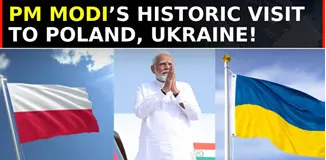
Significance of the Visit:
- Strengthening European Engagement:
- Modi’s visit highlights India’s intent to deepen ties with Central Europe, a region increasingly pivotal in global geopolitics due to the Ukraine conflict.
- The visit signifies India’s commitment to engaging more actively with Europe and filling a key gap in its European policy.
- Central Europe's Role:
- Poland and Ukraine are expected to play significant roles in shaping the new European order post the Ukraine war.
- India aims to build long-term partnerships with these nations while maintaining its relations with Russia and other European powers.
- Diversification of Relations:
- Traditionally focused on major European nations like Russia, Germany, France, and the UK, India has expanded its outreach to Central Europe over the past decade.
- Modi’s visit to Poland and Ukraine follows his previous visits to Austria and other Central European countries, underscoring a strategic shift in India’s European diplomacy.
Poland’s Importance:
- Economic Significance: Poland is the largest economy in Central Europe and has shown rapid economic growth. It ranks eighth in Europe in terms of population and economic influence.
- Strategic Role: Poland's location and economic strength make it a key player in European affairs, and its large population base adds to its geopolitical significance.
Ukraine’s Importance:
- Geopolitical Influence: Ukraine’s role in the ongoing conflict with Russia impacts European security dynamics. Its strategic position and large territory contribute to its significance.
- Economic and Strategic Potential: Despite the war, Ukraine’s potential for reconstruction and its role as a major grain producer add to its strategic importance. Its defence industry, seeking modernization, is a focus of international attention.
India-Poland Relations
- Historical Context:
- Diplomatic ties began in 1954, with the Indian Embassy opening in Warsaw in 1957 and the Polish Embassy in New Delhi in 1954.
- During WWII, Polish refugees found shelter in India, highlighting historical bonds.
- Economic & Commercial Relations:
- Poland is India’s largest trading and investment partner in Central and Eastern Europe. Bilateral trade increased by 192% from 2013 to 2023.
- Indian investment in Poland exceeds $3 billion, while Polish investment in India is about $685 million.
- Key sectors include clean coal technology, chemicals, and textiles.
- Cultural Relations:
- Monuments in Warsaw commemorate Indian contributions during WWII, including the Valivade-Kolhapur camp and the Battle of Monte Cassino.
Key Highlights of PM Modi’s Visit to Poland
- Diplomatic Milestones:
- The visit marks the 70th anniversary of diplomatic relations between India and Poland.
- PM Modi’s visit is aimed at elevating bilateral ties and revitalising the relationship.
- Tributes and Events:
- Modi laid a wreath at the Dobry Maharaja Memorial and other significant memorials in Warsaw.
- He honoured WWII soldiers and addressed the Indian diaspora in Warsaw, reinforcing cultural and historical connections.
Source: LM
Hema Committee Report on Malayalam Film Industry
Why in the news?
- Recently, the Hema committee report on the Malayalam film industry was released, revealing disturbing instances of sexual abuse, gender discrimination, and inhuman treatment of women within the industry.
- The committee, led by retired Kerala High Court judge Justice K Hema, included veteran actor Sharada and retired IAS officer K B Valsala Kumari.
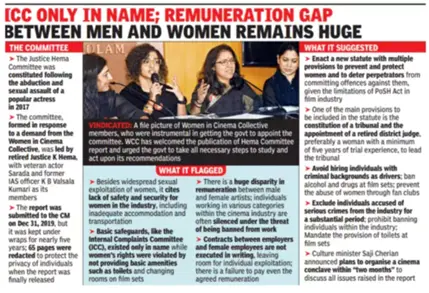
Key Issues Highlighted in the Report:
- Sexual Abuse: The report details unwanted physical advances, threats of rape, and the use of code names for women who agree to compromise.
- Casting Couch: The report exposes the prevalence of the casting couch, where women are coerced into exchanging sexual favours for job opportunities. Female actors often face pressure from directors and producers, leading to significant emotional trauma. The term "casting couch" refers to the practice of soliciting sexual favors from job applicants in exchange for acting roles.
- Safety on Film Set: Many female film workers bring their parents or close relatives to the set due to fears of sexual demands and harassment.
- Criminal Influence: The industry is reported to be plagued by criminal influence, with some men, under the influence of alcohol or drugs, causing distress by knocking on female artists' hotel doors.
- Fear of Consequences: Women in the industry are hesitant to file complaints despite legal protections due to fears of stigma and repercussions.
- Cyberthreats: Women in cinema face online harassment, including cyberbullying, public threats, and defamation. Social media is a common platform for explicit and threatening messages.
- Inadequate Facilities: Female artists often avoid drinking water on set due to poor toilet facilities, which worsen during menstruation, making it difficult to manage sanitary products.
- Inhumane Working Conditions: Junior artists face extremely poor working conditions, with long hours and inadequate remuneration. They are sometimes mistreated and underpaid, with intermediaries misappropriating their earnings.
Legal Framework to Address Sexual Exploitation in the Film Industry:
- Indian Penal Code, 1860 (now Bhartiya Nyaya Sanhita): Sections 354 (assault or criminal force to a woman with intent to outrage her modesty), 354A (sexual harassment), and 509 (word, gesture, or act intended to insult a woman's modesty) address sexual offences.
- Sexual Harassment of Women at Workplace (Prevention, Prohibition, and Redressal) Act, 2013: This law requires the establishment of Internal Complaints Committees (ICC) in workplaces to handle sexual harassment complaints.
- Information Technology (IT) Act, 2000: Addresses the publication and transmission of obscene material in electronic form, including digital content in films.
- Protection of Children from Sexual Offences (POCSO) Act, 2012: Protects children from sexual exploitation and abuse, including in the context of films.
- Immoral Traffic (Prevention) Act, 1956 (ITPA): Aims to prevent trafficking for commercial sexual exploitation.
Key Recommendations of the Report:
- Internal Complaints Committee (ICC):
- The report proposes the mandatory establishment of the ICC under the Sexual Harassment of Women at Workplace (Prevention, Prohibition, and Redressal) Act, 2013.
- The ICC should include representatives from the Film Employees Federation of Kerala (FEFKA) and the Association of Malayalam Movie Artists (AMMA).
- Independent Tribunal Proposal:
- It recommends setting up an independent tribunal to handle cases of harassment and discrimination within the cinema industry.
- The tribunal should conduct in-camera proceedings to ensure complete privacy, with names and details kept confidential from media reports.
- Written Contracts:
- The report suggests that all individuals working in cinema, including coordinators of junior artists, should sign written contracts to safeguard their interests.
- Gender Awareness Training Program:
- Mandatory gender awareness training should be implemented for all cast and crew before beginning production work.
- Training materials should be available in both Malayalam and English and accessible online.
- Women in Producer Role:
- Adequate and timely budgetary support should be provided to incentivize films that promote gender justice, both theoretically and in production practices.
- A single-window system should be established to offer loans at nominal interest rates for movies produced by women (not through proxies) and to streamline shooting permissions.
- This initiative aims to simplify production and encourage more women to enter the film industry.
|
UPSC Civil Services Examination, Previous Year Question (PYQ) Mains Q:1 What are the continued challenges for Women in India against time and space? (2019) Q:2 Is the National Commission for Women able to strategize and tackle the problems that women face in both public and private spheres? Give reasons in support of your answer. (2017) |
Source: TH
2+2 Foreign and Defence Ministerial Meeting
Why in the news?
- India and Japan recently conducted their third 2+2 Foreign and Defence Ministerial Meeting in New Delhi.
- This meeting, held against the backdrop of growing geopolitical tensions and China’s assertiveness in the Indo-Pacific region, focused on strengthening bilateral cooperation across various sectors.
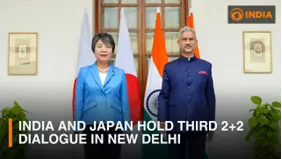
What are 2+2 Meetings?
- About:
- 2+2 meetings are high-level diplomatic dialogues involving the foreign and defence ministers of two countries.
- They provide a platform for comprehensive discussions on strategic, security, and defence issues, aiming to enhance bilateral relations and address mutual concerns.
- India’s 2+2 Partners:
- United States: The first 2+2 dialogue between India and the US took place in 2018, aimed at deepening strategic cooperation.
- Russia: The inaugural 2+2 meeting with Russia was held in 2021, focusing on regional and international issues within a multipolar world context.
- India has also engaged in 2+2 meetings with Australia, Japan, Brazil, and the United Kingdom to strengthen defence and security cooperation.
Key Highlights of the India and Japan 2+2 Meeting:
- Free and Open Indo-Pacific:
- Both nations reaffirmed their commitment to a free, open, and rules-based Indo-Pacific.
- This strategic alignment is influenced by China’s increasing military presence in the region.
- They supported ASEAN’s unity and centrality, endorsing the ASEAN Outlook on the Indo-Pacific (AOIP) which highlights ASEAN's role in regional cooperation and stability.
- Their commitment to the Quadrilateral Security Dialogue (QUAD) was reiterated, building on the discussions from the Quad Foreign Ministers’ Meeting in July 2024.
- Japan and India expressed intentions to collaborate on security assistance to third countries to promote regional peace and stability.
- Defence and Security Cooperation:
- Defence cooperation was highlighted as a cornerstone of their Special Strategic and Global Partnership.
- Progress in multilateral exercises, such as Veer Guardian (2023), Dharma Guardian (Military), JIMEX (naval), SHINYUU Maitri (air force), and Malabar (with Australia and the US), was acknowledged.
- Advances in unmanned ground vehicles (UGVs) and robotics cooperation were noted.
- Both countries agreed to update the 2008 Joint Declaration to address contemporary security challenges.
- Terrorism and Extremism:
- Both nations condemned terrorism and violent extremism, focusing on cross-border terrorism.
- They emphasised the need for justice for the perpetrators of the 26/11 Mumbai attacks and other incidents.
- Efforts to eliminate terrorist safe havens, disrupt financing channels, and prevent terrorist movements were supported, with mentions of groups such as Al Qaeda, ISIS/Daesh, Lashkar-e-Tayyiba (LeT), and Jaish-e-Mohammad (JeM).
- Technology:
- Discussions included the transfer of Japan’s Unified Complex Radio Antenna (UNICORN) and related technologies.
- The Unicorn system integrates multiple antennas into a single structure to minimise radar signatures and enhance detection capabilities for missiles and drones.
- Both sides agreed to explore Japanese naval ship maintenance in India and future defence technology cooperation.
- Women, Peace, and Security (WPS):
- Both countries emphasised the role of women in peacekeeping operations and supported the Women, Peace, and Security (WPS) agenda.
- This agenda, formalised by UN Security Council Resolution (UNSCR) 1325 in 2000, highlights women’s roles in preventing and resolving conflicts, peacebuilding, and post-conflict recovery.
|
UPSC Civil Services Examination, Previous Year Question (PYQ) Prelims Q1. In which one of the following groups are all four countries members of G20? (2020)
Ans: (a) |
Source: TH
Centre debates taking caste count during Census
Why in the news?
- The Union government is deliberating whether to include caste enumeration in the upcoming Census, which has been delayed.
- The complexity and potential for inaccuracies in caste data are central to the debate.
Census in India:
- About:
- Population Census: Provides fundamental statistics on demographics, culture, and economic structure at various levels.
- Historical Context: The first census was non-synchronous in 1872, with the first synchronous census conducted in 1881 under British rule.
- Current Responsibility: Conducted by the Office of the Registrar General and Census Commissioner of India, Ministry of Home Affairs.
- Legal Basis: Listed in the Union List (Entry 69) of the Seventh Schedule of the Indian Constitution, conducted under the Census Act, 1948.
- Process:
- Phases:
- House-listing and Housing Census
- Population Enumeration: Takes place six to eight months after the Housing Census, gathering details like age, marital status, and religion.
- Upcoming Census:
- 16th Census: Scheduled for 2021 but postponed due to COVID-19.
- Digitalization: For the first time, data collection will be digital via a mobile app, with self-enumeration also introduced.
- Phases:
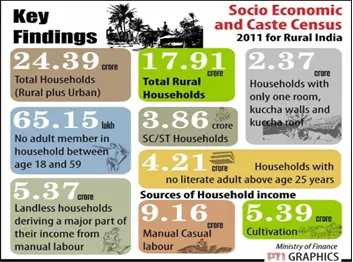
Caste Census:
- About:
- Definition: Inclusion of caste-wise population tabulation in the Census.
- Historical Context:
- British India (1881-1931): Caste was enumerated.
- Post-Independence: Caste enumeration was excluded except for SCs and STs. Data from the 2011 Census on castes were never released.
- Background:
- 1961 Recommendation: States were advised to conduct their own surveys for OBC lists.
- Collection of Statistics Act, 2008: Allows states to gather necessary data independently.
- Demand and Need:
- Affirmative Action: Supports the world’s largest caste-based affirmative action program, affecting reservations in education and jobs.
- Outdated Data: Reliance on 1931 estimates is problematic; a new caste census would provide updated data for accurate policymaking.
- Supreme Court Mandate: Regular data collection was mandated to prevent exploitation of quota benefits.
- Arguments For:
- Updated Data: Provides precise information for social programs and addresses disparities in opportunities.
- Political Support: Leaders like Nitish Kumar and MK Stalin advocate for it to ensure fair distribution of resources.
- Arguments Against:
- Deepening Divisions: Could exacerbate social divisions and entrench caste-based discrimination.
- Administrative Challenges: Complexity and potential inaccuracies, as seen in the 2011 SECC.
- Political Exploitation: Risks increasing caste-based polarisation and could be used to mobilise vote banks.
- Focus Shift: May detract from broader socio-economic issues like poverty, education, and healthcare.
- Past Attempts to count the caste:
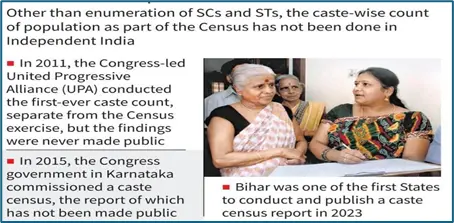
|
UPSC Civil Services Examination, Previous Year Question Prelims Q:1 Consider the following statements: (2009)
Which of the statements given above is/are correct?
Ans: (d) |
Source: TH
Prime Minister Employment Generation Programme (PMEGP)
Why in the news?
- Recently, KVIC and the Department of Posts collaborated to boost PMEGP Implementation across India.

Prime Minister’s Employment Generation Programme (PMEGP)
- About:
- PMEGP is a central sector scheme managed by the Ministry of Micro, Small, and Medium Enterprises (MSME).
- Objectives:
- Employment Generation: The scheme aims to create employment opportunities in both rural and urban areas by facilitating the establishment of new self-employment ventures, projects, or micro-enterprises.
- Support for Artisans and Youth: It seeks to unite traditional artisans and unemployed youth from both rural and urban regions, providing them with self-employment opportunities as close to their homes as possible.
- Sustainable Employment: The program aims to offer continuous and sustainable employment to a broad segment of traditional and aspiring artisans, as well as unemployed youth, thereby helping to curb the migration of rural youth to urban centres.
- Wage Enhancement: By boosting the wage-earning potential of workers and artisans, the scheme contributes to the growth of employment rates in both rural and urban areas.
- Eligibility Criteria:
- Age Requirement: Individuals must be over 18 years of age to be eligible.
- Income Ceiling: There is no income ceiling for receiving assistance under PMEGP for setting up projects.
- Educational Qualification: For projects exceeding Rs. 10 lakhs in the Manufacturing sector and Rs. 5 lakhs in the Business/Service sector, applicants must have at least a standard VIII pass educational qualification.
- Implementing Agency:
- Khadi and Village Industries Commission (KVIC): KVIC is responsible for implementing the PMEGP.
- About Khadi and Village Industries Commission (KVIC):
- Statutory Body: KVIC was established under the Khadi and Village Industries Commission Act of 1956.
- Apex Organization: It operates under the Ministry of Micro, Small, and Medium Enterprises and is the leading body concerning khadi and village industries in India.
- Key Responsibilities: KVIC is tasked with planning, promoting, organising, and implementing programs for the development of khadi and other village industries in rural areas, coordinating with other agencies involved in rural development when necessary.
Source: AIR
Atomic clocks- Lunar time standard
Why in the news?
- Recently, an international astronomical group proposed the establishment of a lunar time standard to support future lunar missions, aiming to resolve time discrepancies on the Moon caused by its distinct gravitational environment.
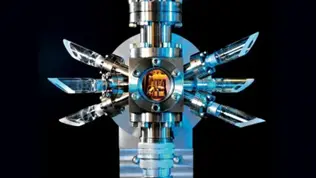
Atomic Clocks:
- About:
- Precision Timekeeping: Atomic clocks are the most accurate timekeeping devices, essential for operations requiring extreme precision, such as in GPS systems, telecommunications, and scientific research.
- Measurement Mechanism: These clocks measure time by detecting the resonant frequencies of atoms, particularly cesium-133.
- Time Definition: In atomic time, one second is defined by the period it takes for a cesium atom to vibrate 9,192,631,770 times.
- Reliability: The consistency and accuracy of atomic vibrations make atomic clocks the most dependable instruments for precise time measurement.
- Functioning of an Atomic Clock:
- Cesium Atoms: Atomic clocks use cesium atoms, which vibrate at a stable and exact frequency. The process starts in a microwave cavity containing cesium vapour.
- Microwave Signal: A microwave signal is applied to this cavity, causing the cesium atoms to vibrate and emit radiation at a specific frequency.
- Frequency Detection: The emitted frequency is detected and compared to a standard frequency.
- Time Adjustment: Any discrepancies between the frequencies are corrected, ensuring the clock maintains precise timekeeping.
- Types of Atomic Clocks:
- Cesium Atomic Clocks: These are the most common and are used to define Coordinated Universal Time (UTC), the international time standard.
- Hydrogen Maser Atomic Clocks: Even more accurate than cesium clocks, these are mainly used in scientific research due to their exceptional precision.
Why a Lunar Time Standard is Necessary:
- Precision for Lunar Missions: A lunar time standard is crucial for accurate timekeeping on the Moon, particularly for spacecraft and satellite missions requiring extreme accuracy.
- Synchronisation: This standard would synchronise communication between satellites, astronauts, lunar bases, and Earth, facilitating coordinated operations and reliable lunar commerce.
- Gravitational Impact:
- Due to the Moon's lower gravity, time passes slightly faster on the Moon compared to Earth.
- An Earth-based clock would lose about 7 microseconds per Earth Day when observed from the Moon, causing additional periodic variations.
- Operational Challenges: These discrepancies can pose significant challenges, such as in spacecraft docking on the Moon, precise data transfers, and maintaining reliable communication and navigation.
How Earth’s Time Standard Works:
- Coordinated Universal Time (UTC): Earth’s timekeeping system is based on UTC, an internationally agreed-upon standard ensuring consistency.
- International Atomic Time (TAI): UTC relies on TAI, maintained by atomic clocks worldwide, to provide precise and uniform timekeeping.
- Maintenance of UTC: UTC is maintained by the International Bureau of Weights and Measures in Paris, France, and is derived from a weighted average of over 400 atomic clocks globally.
- Time Zones:
- To determine local time, countries adjust UTC by adding or subtracting hours based on their geographical position relative to the 0-degree longitude meridian, known as the Greenwich Meridian.
- Countries west of the Greenwich Meridian subtract from UTC, while those to the east add to it.
Source: IE
Waterspout
Why in the news?
- Recently, a luxury yacht sank off the coast of Sicily, Italy, amid a violent storm, leading to one confirmed death and six people reported missing. This incident is suspected to have been caused by a waterspout.
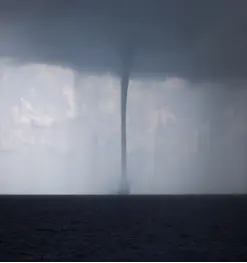

Waterspouts:
- About:
- Waterspouts are notable atmospheric events characterised by rotating columns of air that form over water bodies.
- These tornado-like phenomena typically occur over seas or large lakes, showcasing the raw power of nature.
- Nature: Waterspouts are a weaker version of tornadoes, typically lasting between 5-10 minutes.
- Size: The average diameter of a waterspout is around 165 feet (50 meters).
- Wind Speed: Wind speeds within a waterspout can reach up to 100 km/h (60 mph).
- Formation of Waterspouts:
- Fair-Weather Waterspouts: These form when cool air moves over open water, pulling water upwards and creating the waterspout.
- Tornadic Waterspouts: These are more likely to develop during thunderstorms and may originate as tornadoes on land before moving over water.
Waterspouts develop through a distinct five-stage process:
- Dark Spot: A light-coloured disk appears on the water’s surface, surrounded by a darker area with blurred edges.
- Spiral Pattern: Bands of light and dark colours spiral outward from the dark spot.
- Spray Ring: The dark spot creates a swirling mass of sea spray, resembling a hurricane's eye.
- Mature Vortex: The spray ring forms a spinning funnel extending from the water’s surface to the clouds above.
- Decay: As warm air disrupts the vortex, the waterspout weakens and dissipates.
- Condition: The key to waterspout formation is the presence of cold air circulating over warm water. When these conditions are met, a waterspout can form.
- Occurrence: While most common in tropical and subtropical regions, waterspouts can occur in various parts of the world, including Europe, the Middle East, and even Antarctica.
Types of Waterspouts:
- Tornadic Waterspouts:
- Essentially tornadoes over water.
- Associated with severe thunderstorms.
- Can be accompanied by dangerous conditions such as high winds, large hail, and frequent lightning.
- Fair-Weather Waterspouts:
- Form under calmer conditions, often at the base of developing cumulus clouds.
- Generally, not associated with thunderstorms.
- Develop from the water's surface upward and typically move little due to light wind conditions.
- Snowsports:
- Exceptionally rare, forming under the base of a snow squall.
- Occasionally referred to as snow devils.
- Typically weak, but in some cases, they can reach the strength of an EF1 tornado.
- Recent:
- Recent research from the University of Barcelona suggests a link between warmer sea surface temperatures and an increase in waterspout formation.
- For example, the sea surface near Sicily has been observed to be 2.5 to 3 degrees Celsius warmer than the 1990-2020 average, potentially contributing to increased waterspout activity.
Source: IE
Orangutan diplomacy
Why in the news?
- Recently, Malaysia has launched an initiative called "Orangutan Diplomacy" to tackle sustainability issues linked to palm oil production and deforestation affecting orangutans.

About Orangutans:
- Description: Orangutans are the largest tree-dwelling mammals, known for their distinct red fur. They are predominantly arboreal, spending over 90% of their waking hours in trees.
- Intelligence: Highly intelligent, orangutans share approximately 4% of their genes with humans, underscoring their conservation importance.
- Distribution: They are native to the Indonesian island of Sumatra and the Malaysian and Indonesian regions of Borneo. Their habitat ranges from lowland peat swamp forests to high-altitude mountainous forests, up to nearly 6 kilometers above sea level.
- Species: There are three species of orangutans: Bornean, Sumatran, and Tapanuli.
- Characteristics:
- Size: Adult males can be up to 3 meters tall and weigh up to 130 kg in the wild, generally about twice the size of females.
- Appearance: They have long, sparse orange or reddish hair and possess long arms relative to their legs, with grasping hands and feet featuring long, curved fingers and toes. Mature males have distinctive cheek pads.
- Lifespan: Orangutans can live up to 50 years in the wild.
- Diet: Their diet is primarily fruit and leaves, including lychees and figs, but also includes nuts, bark, insects, and occasionally bird eggs.
- Social Structure: While orangutans are among the most solitary great apes, they exhibit social tolerance during periods of abundant fruit, forming groups called parties.
- Conservation Status: All three species of orangutans are listed as 'Critically Endangered' on the IUCN Red List.
Source: IE
Lateral entry in UPSC will further distance marginalised
Why in the news?
- The Indian government's cancellation of the lateral entry process for government posts, due to the absence of reservation quotas for SCs and STs, reflects a complex mix of political, social justice, and historical factors.
- This decision underscores the ongoing debate over balancing merit and representation, highlighting the need to address marginalised communities' concerns while promoting inclusivity in government recruitment.
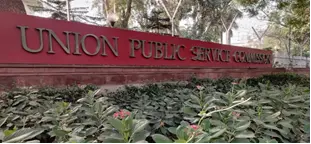
What is Lateral Entry in Indian Bureaucracy?
- About:
- Lateral entry into the Indian bureaucracy involves hiring experts from the private sector, academia, or public sector undertakings (PSUs) for specific government roles.
- This method contrasts with traditional internal promotions within the government and applies to positions such as Joint Secretary, Director, or Deputy Secretary.
- Purpose:
- To introduce specialised knowledge and expertise for addressing complex governance and policy issues.
- To infuse new perspectives and innovative approaches into government operations.
- Appointment Process:
- Candidates are appointed on contracts, generally lasting from three to five years, with possible extensions based on performance.
- Specific academic qualifications and relevant professional experience are prerequisites.
- Eligibility:
- Candidates typically require a minimum of 15 years of relevant experience in their field.
- Requirements vary depending on the specific post, seniority, and job profile.
What is the History of Lateral Entry Recruitments in India?
- Early Instances (1950s onwards):
- Lateral entry practices began during Prime Minister Jawaharlal Nehru’s tenure.
- Notable instances include IG Patel, who transitioned from the International Monetary Fund to RBI Governor, and Manmohan Singh, who moved from a professor at the Delhi School of Economics to Economic Adviser in 1971.
- Formal Recommendations (2005):
- The Second Administrative Reforms Commission (ARC), chaired by Veerappan Moily, recommended lateral entry to introduce specialised knowledge missing in traditional civil services.
- NITI Aayog Proposal (2017):
- NITI Aayog proposed lateral entry at middle and senior management levels in the central secretariat as part of its three-year Action Agenda, supported by the Sectoral Group of Secretaries on Governance.
- Formal Recruitment Drives (2018-2023):
- The central government advertised lateral entry positions, initially for Joint Secretary roles, receiving over 6,000 applications.
- In 2019, 9 candidates were appointed to various Ministries and Departments.
- Subsequent recruitment rounds occurred in 2021 and May 2023, totalling 63 appointments over five years, with 57 currently active
What are Benefits of Lateral Entry in Indian Bureaucracy?
- Infusion of Specialised Expertise:
- R.V. Shahi: His experience as Power Secretary led to significant electricity sector reforms.
- Bimal Jalan: His role during the East Asian financial crisis and in financial sector reforms.
- Vijay Kelkar: His recommendations for the introduction of GST.
- These experts contribute specialised knowledge to critical areas such as technology, climate change, and the digital economy, enhancing policy effectiveness.
- Enhanced Innovation and Efficiency:
- Streamlining government processes.
- Improving efficiency with cutting-edge technologies.
- Examples include Nandan Nilekani's contributions to UIDAI and ONDC.
- Their fresh perspectives help reduce bureaucratic red tape and improve service delivery.
- Bridge Between Public and Private Sectors:
- Providing insights into market dynamics.
- Crafting practical policies and incentives.
- Enhancing collaboration in areas like urban development and infrastructure.
- Their dual sector experience aids in aligning government policies with industry needs.
- Global Perspective and Best Practices:
- Enhancing India’s global economic and diplomatic standing.
- Navigating international agreements on issues like climate change and trade.
- Their global outlook can improve India's competitiveness and policy effectiveness.
- Enhancing Policy Implementation:
- More practical and feasible policies.
- Effective regulatory frameworks.
- Example: Insights from renewable energy professionals can aid in scaling up clean energy technologies.
- Mitigating Bureaucratic Inertia:
- Stimulates innovative thinking.
- Creates healthy competition among bureaucrats.
- Example: New approaches in agriculture or technology brought by lateral entrants can invigorate government departments.
- Facilitating Major Economic Reforms:
- Designing and implementing complex economic reforms.
- Balancing growth with social equity.
- Historical example: Montek Singh Ahluwalia’s role in India’s 1991 economic liberalisation.
What are Challenges Related to Lateral Entry in Indian Bureaucracy?
- Reservation Conundrum:
- Lateral entry positions are exempt from reservation quotas due to the "13-point roster" policy, treating each as a "single post cadre."
- The cancellation of 45 such positions in August 2024 highlights concerns about undermining representation for marginalised communities.
- Cultural Misalignment and Integration Hurdles:
- Lateral entrants may struggle with the government's unique culture and slow decision-making processes, leading to inefficiencies and potential high turnover due to friction between new entrants and established practices.
- Resistance from Career Bureaucrats:
- Career bureaucrats might resist lateral entrants, seeing them as threats to their positions, resulting in non-cooperation or sabotage, which can hinder the effectiveness of new initiatives.
- Accountability and Performance Evaluation:
- Lateral entrants on short-term contracts face difficulties in performance evaluation compared to career bureaucrats.
- Their limited tenure complicates long-term impact assessment and creates potential inequities in evaluation.
- Potential for Conflict of Interest:
- Lateral entrants may face conflicts of interest if they return to previous industries after their tenure, raising ethical concerns and affecting public trust.
- Effective ethical guidelines and cooling-off periods are challenging to enforce.
- Short-Term Focus vs. Long-Term Governance:
- With contracts typically lasting 3-5 years, lateral entrants may focus on short-term results rather than long-term policy consistency, potentially leading to policy inconsistencies and lack of continuity.
- Scaling and Sustainability Concerns:
- Expanding lateral entry to a significant portion of the bureaucracy poses challenges in recruitment, training, and integration.
- The current 63 appointments over five years represent a small fraction, raising concerns about scalability and sustainability.
What are the Major Reforms Needed in Indian Bureaucracy?
- Meritocracy Makeover - Overhauling Recruitment and Promotion:
- Implement a merit-based system as recommended by the 2nd Administrative Reforms Commission (2008), including the creation of a Central Civil Services Authority for autonomy and objectivity.
- Establish regular assessment centres for promotions, focusing on leadership and expertise.
- Form an independent Civil Services Board to oversee appointments and transfers, reducing political interference.
- Specialisation Synergy - Nurturing Expertise in Governance:
- Develop specialised cadres in key sectors like technology, finance, and healthcare.
- Implement mandatory domain specialisation after 10 years of service.
- Partner with top universities for continuous professional education.
- Work Culture Transformation:
- Modernise work culture by reducing hierarchical structures and empowering officers with decision-making authority.
- Abolish the outdated 'babu' culture to create a leaner, more efficient government.
- Performance Paradigm - Result-Oriented Accountability:
- Replace the current system with a performance-based appraisal system as suggested by the Hota Committee (2004).
- Implement a 360-degree feedback mechanism and key performance indicators (KPIs) for senior positions.
- Introduce performance-linked incentives and fast-track promotions.
- Digital Transformation - Leveraging Technology for Governance:
- Implement a nationwide e-governance platform to integrate government services.
- Use AI and data analytics for evidence-based policymaking.
- Appoint Chief Digital Officers in every ministry to drive digital transformation.
- Reinforcing Accountability:
- Conduct intensive reviews for government servants at 14 and 20 years to assess their suitability for continued service.
- Discontinue service if found unfit after 20 years, with future employment contingent on review outcomes.
- Depoliticization of Civil Services:
- Ensure political neutrality by including ethical codes for both ministers and public servants.
- Maintain transparent recruitment processes and adhere to Supreme Court directives to protect civil servants from political interference.
Conclusion
Lateral entry can enhance Indian bureaucracy with new expertise and innovation but faces challenges like reservation issues, cultural mismatches, resistance from career bureaucrats, and conflicts of interest. Success depends on balancing innovation with tradition, ensuring fair integration, and maintaining the strengths of the existing system. Properly managed, it can improve diversity and responsiveness in governance.
|
UPSC Civil Services Examination, Previous Year’s Question (PYQs) Mains Q:1 “Institutional quality is a crucial driver of economic performance”. In this context suggest reforms in the Civil Service for strengthening democracy. (2020) |
Source: IE
Share the article
Edukemy’s Current Affairs Quiz is published with multiple choice questions for UPSC exams
MCQ
Get Latest Updates on Offers, Event dates, and free Mentorship sessions.

Get in touch with our Expert Academic Counsellors 👋
FAQs
UPSC Daily Current Affairs focuses on learning current events on a daily basis. An aspirant needs to study regular and updated information about current events, news, and relevant topics that are important for UPSC aspirants. It covers national and international affairs, government policies, socio-economic issues, science and technology advancements, and more.
UPSC Daily Current Affairs provides aspirants with a concise and comprehensive overview of the latest happenings and developments across various fields. It helps aspirants stay updated with current affairs and provides them with valuable insights and analysis, which are essential for answering questions in the UPSC examinations. It enhances their knowledge, analytical skills, and ability to connect current affairs with the UPSC syllabus.
UPSC Daily Current Affairs covers a wide range of topics, including politics, economics, science and technology, environment, social issues, governance, international relations, and more. It offers news summaries, in-depth analyses, editorials, opinion pieces, and relevant study materials. It also provides practice questions and quizzes to help aspirants test their understanding of current affairs.
Edukemy's UPSC Daily Current Affairs can be accessed through:
- UPSC Daily Current Affairs can be accessed through Current Affairs tab at the top of the Main Page of Edukemy.
- Edukemy Mobile app: The Daily Current Affairs can also be access through Edukemy Mobile App.
- Social media: Follow Edukemy’s official social media accounts or pages that provide UPSC Daily Current Affairs updates, including Facebook, Twitter, or Telegram channels.

